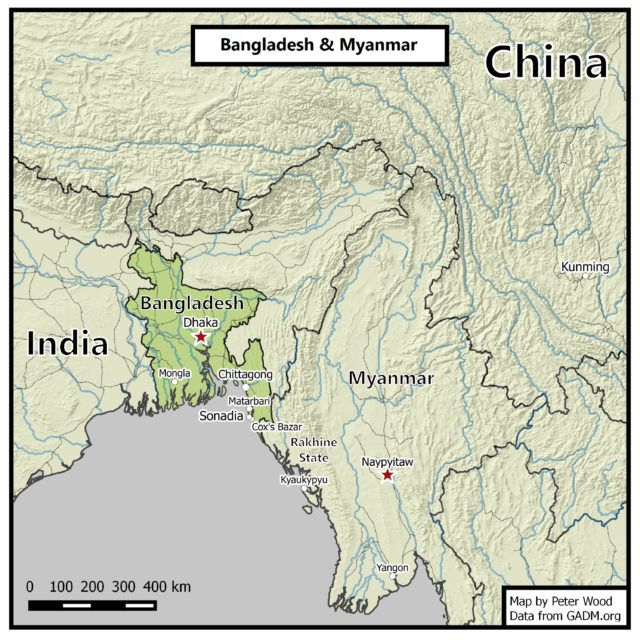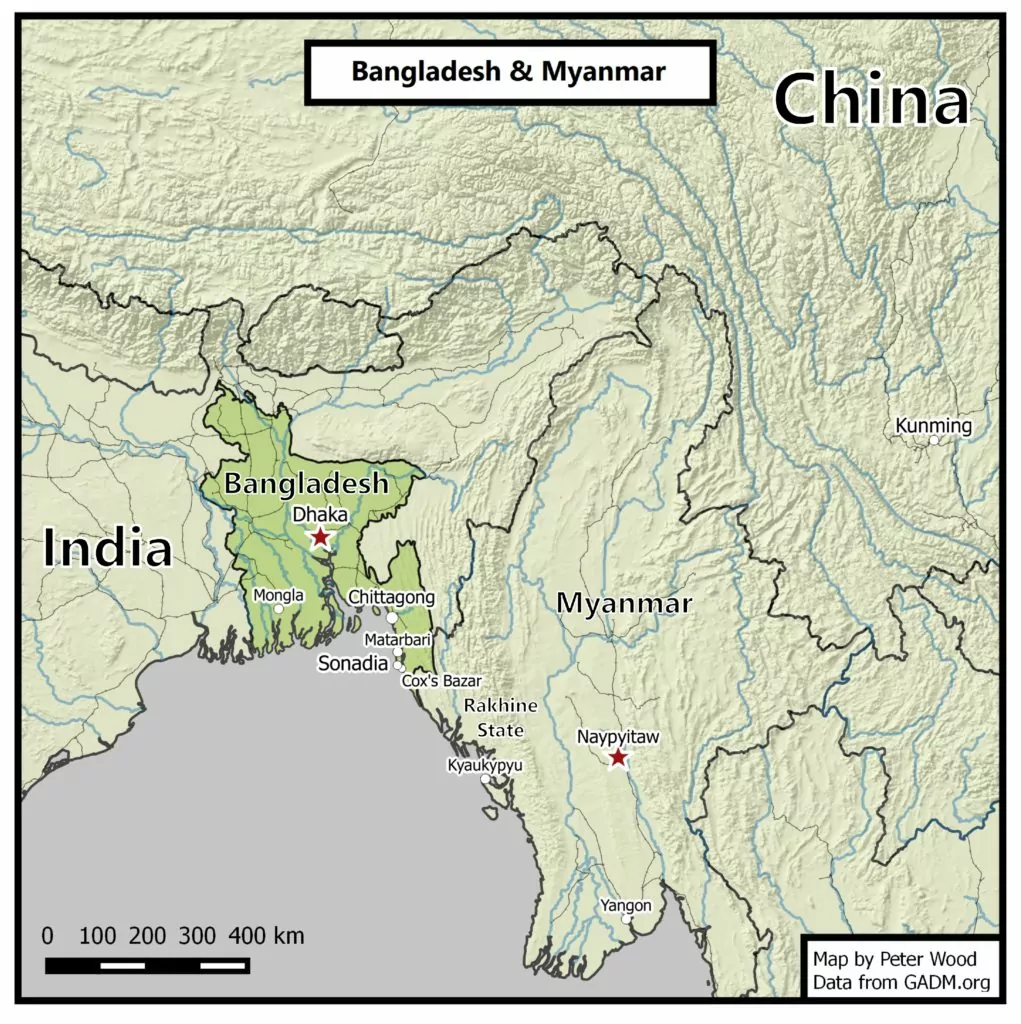
Rohingya Crisis: Will China’s Mediation Succeed?
Publication: China Brief Volume: 17 Issue: 15
By:

During his visits to Dhaka, Bangladesh and Naypyitaw, Myanmar on November 18 and 19, China’s Foreign Minister Wang Yi put forward a three-phase plan to resolve the Rohingya crisis. First, Wang called for a ceasefire in Myanmar’s devastated Rakhine state, which is at the center of the crisis. Aimed at restoring order and stability in the Rakhine state, the ceasefire is expected to halt the flow of Rohingya refugees to Bangladesh. China envisages that this will pave the way for the second stage: negotiations between Myanmar and Bangladesh to address the refugee problem. The third and final stage will involve the economic development of the Rakhine state to address the underlying causes of the violence (Global Times, November 20). China’s plan has reportedly found acceptance in Naypyitaw and Dhaka and marks the start of a new phase in Beijing’s involvement in the Rohingya conflict (FMPRC, November 20). China’s role has hitherto been limited to providing humanitarian aid to the Rohingya refugees and protecting Myanmar from international censure. Why is China now adopting a mediatory role in the conflict? And is it likely to succeed in bringing peace to a restive region?
The Rohingya Conflict
The Rohingya crisis began on August 25 when the Myanmar government declared the Arakan Rohingya Salvation Army (ARSA) a terrorist organization in response to deadly attacks on police and army posts in Rakhine state in western Myanmar (Mizzima, August 28). It also launched a military crackdown in Rakhine, which it maintains is aimed at the militants (Mizzima, October 16; Terrorism Monitor, November 10). However, horrific violence has been unleashed on Rohingya civilians, including women and children. Entire villages have been razed. Over 600,000 of the estimated 1.1 million Rohingya in Myanmar are reported to have fled to Bangladesh (The Wire, November 17). The current crisis is the most severe that the decades-old Rohingya conflict has witnessed.
While the roots of the Rohingya conflict (like Myanmar’s other ethnic conflicts) can be traced back to colonial times, independence brought with it discrimination against the Rohingya that became systematic and serious. A Muslim ethnic group that has inhabited the Rakhine state for centuries, the Rohingya do not figure among Myanmar’s 135 official ethnic groups. Since 1982, they have been denied citizenship, effectively rendering them stateless (Daily Sabah, October 23). In addition to suffering at the hands of the military, the Rohingya have been targeted by Rakhine Buddhist vigilante groups too (The Wire, November 17). The violence has triggered waves of Rohingya migration to neighboring countries like Bangladesh, Thailand, India, Malaysia, and Indonesia. Unwelcome in these countries as well, Rohingya refugees have been pushed back or languish in makeshift, overcrowded camps (The National, September 13).
China’s Support
The Myanmar military’s reported atrocities against fleeing Rohingya civilians have evoked international outrage. UN Human Rights Council Chief Zeid Ra‘ad al-Hussein described the situation in the Rakhine state as “a textbook example of ethnic cleansing” (UN News Centre, September 11). Several Muslim countries and the western powers have criticized Myanmar’s brutal crackdowns on the Rohingya too (Arab News, September 5 and FirstPost, September 23).
However, China has publically praised the Myanmar government’s crackdowns in Rakhine. In September, the Chinese ambassador to Myanmar, Hong Liang, “strongly welcomed” “the counterattacks of Myanmar security forces against [Rohingya] extremist terrorists” and described its military campaign as “just an internal affair” (The Global New Light of Myanmar, September 14). Later that month, Hong assured the Myanmar government that China would stand “firmly” by it on the international stage and continue providing it with “necessary assistance” to help it “uphold internal stability and development” (The Irrawaddy, September 27).
At the UN, China has blocked resolutions against Myanmar and forced statements critical of its brutal military campaign against the Rohingyas to be watered down. On November 6, for instance, the UN Security Council (UNSC) expressed “grave concern over reports of human rights violations and abuses in Rakhine State” and called on the Myanmar government “to ensure no further excessive use of military forces” there (United Nations, November 6). While this was strong censure of the Myanmar military’s use of force against the Rohingya, this being a statement—and not a resolution—is not enforceable. China and Russia are reported to have forced the UNSC to issue a presidential statement rather than a resolution. The UNSC statement denounces Myanmar’s violent handling of the crisis but it is inconsequential.
China’s Interests in Rakhine
China’s interest in the Rakhine state stems from its strategic location and rich resources. The state is located on the Bay of Bengal, which opens into the Indian Ocean. Like Pakistan’s Gwadar port, which enables Beijing to transport West Asian oil, gas and other commodities through a shorter route via Pakistan to underdeveloped western China, the long Rakhine coastline provides southern China with access to the sea and eastern China with a shorter route to the Indian Ocean (China Brief, July 31, 2015 and Mizzima, October 31). Ports and pipelines in Rakhine significantly free China’s trade with Africa and West Asia, especially its oil imports, from dependence on the congested Straits of Malacca (China Brief, July 31, 2015).
Additionally, Rakhine is rich in natural resources. Large gas reserves were discovered in the waters off its coast in 2004. Beginning in 2008, China has bought gas from the area and transported it from Kyaukphyu on Rakhine’s coast to China’s Yunnan Province through the Myanmar-China Gas Pipeline since 2013. This gas meets the needs of China’s Yunnan, Guizhou and Guangxi provinces as well as that of other counties and cities. Since April this year, oil from Rakhine is being transported to China through a pipeline running parallel to the gas pipeline (China Daily, May 11 and Mizzima, October 31).
China is said to have invested around $2.5 billion in the oil and gas pipeline projects and is also investing $10 billion in the Kyaukphyu Special Economic Zone, which will include a deep-sea port and an industrial park, with the goal of turning Kyaukphyu into a maritime economic hub (Mizzima, October 31).
The areas that are the worst affected by the ongoing violence are in the north of Rakhine, near Myanmar’s border with Bangladesh. Although neither Kyaukphyu nor the oil and gas pipelines are located in or run through these restive areas, Beijing is still concerned. The rise of ARSA and its mounting capacity to carry out attacks on well-secured targets indicates that it is only a matter of time before it strikes outside its stronghold. This has triggered concern in Beijing over the safety of infrastructure it has invested and built in the Rakhine state.
The Rakhine state plays a significant role in China’s Belt and Road Initiative (BRI). Like Gwadar port in Pakistan, Kyaukphyu port and Myanmar will be important links in both the Maritime Belt and Silk Road components of the BRI. As a result, the “stability of Rakhine” is regarded as “important” to the success of the BRI, political and ethnic affairs analyst U Maung Maung Soe has said (The Irrawaddy, September 4). Concerns over the impact that violence and unrest in Rakhine could have on the success of its projects in Myanmar and the BRI, in particular, underlie China’s interest to end the Rohingya crisis and restore stability in the region.

China’s Strong Ties with Bangladesh
China has similarly invested heavily in upgrading and building port infrastructure, roads, bridges and railway lines in Bangladesh too. It is also Bangladesh’s top trade partner; Bangladesh provides a large market for Chinese goods. Defense ties are strong as well; Bangladesh is the second largest importer of Chinese weapons (after Pakistan) and accounted for 82 percent of all Bangladesh weapons purchases between 2009–2013 (China Brief, June 21, 2016).
China is also keen to protect its strong and growing interests and ties in Bangladesh. There is concern in Bangladesh about Myanmar’s military campaign against the Rohingya, which is directly responsible for the flood of refugees into Bangladesh and has left Dhaka with the burden of providing shelter and relief to the Rohingya refugees. Not only has Myanmar’s military strategy contributed to the refugee exodus but also, this has triggered Rohingya militancy. For Bangladesh, which is grappling with an array of jihadist groups already, the emergence of ARSA and the reported training of its cadres in sanctuaries in Bangladesh, poses an additional security threat. China’s endorsement of Myanmar’s strategy on the Rohingya issue has understandably evoked “great disappointment” in Dhaka (Daily Star, November 13).
To ease Dhaka’s burden of looking after the Rohingya refugees, China is providing aid, including tents and blankets to Rohingya refugees in Bangladesh (Xinhuanet, October 13). Chinese leaders are concerned with Bangladesh’s attempts to draw extra-regional powers to intervene in the crisis, prompting Beijing to accelerate efforts to bring Myanmar and Bangladesh to the negotiation table and end the refugee problem.
Will China’s Mediation Work?
In the past, China avoided playing mediator in conflicts beyond its borders, arguing that this went against its principle of non-interference in the internal affairs of sovereign countries. However, in recent years it has shown increasing willingness to mediate an end to conflicts. It has, for instance, been involved in efforts to bring the Afghan government and the Taliban to the negotiation table (Express Tribune, March 7). More recently, it undertook shuttle diplomacy between Afghanistan and Pakistan to arrest spiraling tensions between the two neighbors (Times of India, June 26). China appears to be taking on a mediatory role in regions where it has strong economic and other interests, and is the primary motivation behind Beijing’s mediation in the Rohingya crisis.
China’s promotion of a military-economic development approach to the Rohingya crisis can be expected to worsen the conflict. Development of a violent region by external actors rarely benefits locals, as seen in Pakistan’s Baluchistan province. China’s development of Gwadar port in the region prompted militants to target outsiders (Express Tribune, April 12, 2015; China Brief, July 31, 2015). Projects in Rakhine are likely to benefit foreign investors, Rakhine Buddhists and the Barmar majority, not the marginalized Rohingya. Development that does not result in economic inclusion of the Rohingya will deepen existing grievances and generate new conflicts.
To resolve the conflict, it is important that Myanmar tackle the roots of the problems, which are primarily political: denial of citizenship and rights to the Rohingya people and discriminatory policies. China is unlikely to nudge Myanmar on the citizenship issue. Moreover, Myanmar’s military is known to be sensitive regarding state sovereignty, and is unlikely to respond positively to Chinese pressure on these issues.
China may have significant political and economic influence in Bangladesh and Myanmar but it lacks other qualities that a mediator would need to succeed in settling the Rohingya conflict. Notably, Bangladesh believes that China is biased towards Myanmar, and Beijing’s substantial economic and other interests in Rakhine can be expected to fuel Myanmar’s suspicions of China’s intentions and actions.
Conclusion
Chinese mediation is unlikely to resolve the Rohingya conflict. At best, its intervention could keep a lid on the violence being unleashed by the Myanmar military in the Rakhine state. This could usher in a measure of stability but not peace in Rakhine. In the future, China can be expected to offer to mediate in conflicts within and between countries where it has significant interests, especially involving countries that are part of the Belt and Road Initiative.




